| المجموعات الإجتماعية |
| البحث |
| مشاركات اليوم |
 |
| هندسة وصيانة الطائرات Engineering & Aircraft Maintenance يختص بشرح منظومات الطائرة والرد على استفسارات مهندسي الطيران. راجع الفهرس من هنا |
| إضافة رد |
|
|
أدوات الموضوع |
 |
| هندسة وصيانة الطائرات Engineering & Aircraft Maintenance يختص بشرح منظومات الطائرة والرد على استفسارات مهندسي الطيران. راجع الفهرس من هنا |
| إضافة رد |
|
|
أدوات الموضوع |
| مشاركة [ 1 ] | ||||
|
||||
|
|
  وشكرا |
|||
|
|

|
| مشاركة [ 2 ] | ||||
|
||||
|
|
هذي ناسي اسمها والله ولكن وظيفتها تغطية اجزاء الهيدروليك الخاص بسحب الفلابس وارجاعها لمكانها ..
|
|||
|
|

|
| مشاركة [ 3 ] | ||||
|
||||
|
|
كما ذكر لك الاخ احمد علما اعتقد
|
|||
|
|

|
| مشاركة [ 4 ] | ||||
|
||||
|
|
أخي الكريم هذا الجزء يعرف بأسم (Moveable Track) حيث يوجد بداخلة بعض مشغلات الـ Flap مثل الـ Drive lever و Flap Link Arm وأهمها الـ Track وهو عبارة عن قضيب كقضيب السكة حديد حيث ينزلق علية الـ Flap صعوداً وهبوطاً.
وهو يتخز هذا الشكل الأنسيابي الأيروداينميكي من أجل تقليل مقاومة الهواء أو مايعرف بالـ Drag |
|||
|
|

|
| مشاركة [ 5 ] | ||||
|
||||
|
|
حياك الله كابتن عبدالسلام لم تحدد اين بالضبط في الصورة لكن اذا كنت تقصد هذي القطعة  فهذه تسمى بالFairing وهي مصنعة من مواد مركبة composite خفيفة الوزن تقوم على حماية الأجزاء الداخلية لل flap transmission وهي وحدة تحريك الflap ,ويكون ذلك بتدوير ال ball screw وعند دورانه يتحرك ال carriage وهي قطعة من المعدن تقوم على حمل الflap فعندما يقوم الطيار بإنزال الflap يدور ال ball screw عكس عقارب الساعة مما يجعل ال carriage يتحرك بعيداً عن الجناح كما هو موضح في الصورة  والفائدة الثانية للFairing المحافظة على الشكل الديناميكي لتقليل الDrag الحاصل نتيجة إصطدام الهواء بالطائرة أتمنى أن أكون وضحت المطلوب وحياك الله |
|||
|
|

|
| مشاركة [ 6 ] | ||||
|
||||
|
|
معلووومات اول مره اسمع عنها
تحياتي للجميع |
|||
|
|

|
| مشاركة [ 7 ] | ||||
|
||||
|
|
هذي ناسي اسمها والله ولكن وظيفتها تغطية اجزاء الهيدروليك الخاص بسحب الفلابس وارجاعها لمكانها ..
شكرا جزيلا اخي الكريم |
|||
|
|

|
| مشاركة [ 8 ] | ||||
|
||||
|
|
أخي الكريم هذا الجزء يعرف بأسم (Moveable Track) حيث يوجد بداخلة بعض مشغلات الـ Flap مثل الـ Drive lever و Flap Link Arm وأهمها الـ Track وهو عبارة عن قضيب كقضيب السكة حديد حيث ينزلق علية الـ Flap صعوداً وهبوطاً. وهو يتخز هذا الشكل الأنسيابي الأيروداينميكي من أجل تقليل مقاومة الهواء أو مايعرف بالـ Drag سلمت يداك وصلت المعلومة كابتن طارق |
|||
|
|

|
| مشاركة [ 9 ] | ||||
|
||||
|
|
حياك الله كابتن عبدالسلام لم تحدد اين بالضبط في الصورة لكن اذا كنت تقصد هذي القطعة  فهذه تسمى بالFairing وهي مصنعة من مواد مركبة composite خفيفة الوزن تقوم على حماية الأجزاء الداخلية لل flap transmission وهي وحدة تحريك الflap ,ويكون ذلك بتدوير ال ball screw وعند دورانه يتحرك ال carriage وهي قطعة من المعدن تقوم على حمل الflap فعندما يقوم الطيار بإنزال الflap يدور ال ball screw عكس عقارب الساعة مما يجعل ال carriage يتحرك بعيداً عن الجناح كما هو موضح في الصورة  والفائدة الثانية للFairing المحافظة على الشكل الديناميكي لتقليل الDrag الحاصل نتيجة إصطدام الهواء بالطائرة أتمنى أن أكون وضحت المطلوب وحياك الله
شرح مبسط ودقيق ويسير وصلت المعلومة ... وشكرا جزيلا تسلم كابتن ماشين |
|||
|
|

|
| مشاركة [ 10 ] | ||||
|
||||
|
|
حياك الله كابتن عبدالسلام لم تحدد اين بالضبط في الصورة لكن اذا كنت تقصد هذي القطعة  فهذه تسمى بالFairing وهي مصنعة من مواد مركبة composite خفيفة الوزن تقوم على حماية الأجزاء الداخلية لل flap transmission وهي وحدة تحريك الflap ,ويكون ذلك بتدوير ال ball screw وعند دورانه يتحرك ال carriage وهي قطعة من المعدن تقوم على حمل الflap فعندما يقوم الطيار بإنزال الflap يدور ال ball screw عكس عقارب الساعة مما يجعل ال carriage يتحرك بعيداً عن الجناح كما هو موضح في الصورة  والفائدة الثانية للFairing المحافظة على الشكل الديناميكي لتقليل الDrag الحاصل نتيجة إصطدام الهواء بالطائرة أتمنى أن أكون وضحت المطلوب وحياك الله
شرح رائع وجميل أشكرك عليه مهندس \ علي |
|||
|
|

|
| مشاركة [ 11 ] | ||||
|
||||
|
|
مشكور على الشرح الرائع
|
|||
|
|

|
| مشاركة [ 12 ] | ||||
|
||||
|
|
حياك الله كابتن عبدالسلام لم تحدد اين بالضبط في الصورة لكن اذا كنت تقصد هذي القطعة  فهذه تسمى بالFairing وهي مصنعة من مواد مركبة composite خفيفة الوزن تقوم على حماية الأجزاء الداخلية لل flap transmission وهي وحدة تحريك الflap ,ويكون ذلك بتدوير ال ball screw وعند دورانه يتحرك ال carriage وهي قطعة من المعدن تقوم على حمل الflap فعندما يقوم الطيار بإنزال الflap يدور ال ball screw عكس عقارب الساعة مما يجعل ال carriage يتحرك بعيداً عن الجناح كما هو موضح في الصورة  والفائدة الثانية للFairing المحافظة على الشكل الديناميكي لتقليل الDrag الحاصل نتيجة إصطدام الهواء بالطائرة أتمنى أن أكون وضحت المطلوب وحياك الله
حياك الله اخي الكريم ابو ود المحترم مع احتراماتي لكل الاخوة المشاركين بس انت اجبت اجابة رائعة |
|||
|
|

|
| مشاركة [ 13 ] | ||||
|
||||
|
|
I believe the A340 pods you are referring to are the flap track fairings located along the trailing edge of the wing. These fairings house the mechanisms used to deploy the wing flaps. The pods are not unique to the A-340 but are carried aboard virtually every airliner in use today, including all Boeing and Airbus models in production. Examples of flap track fairings can be seen in the following picture of an A-310
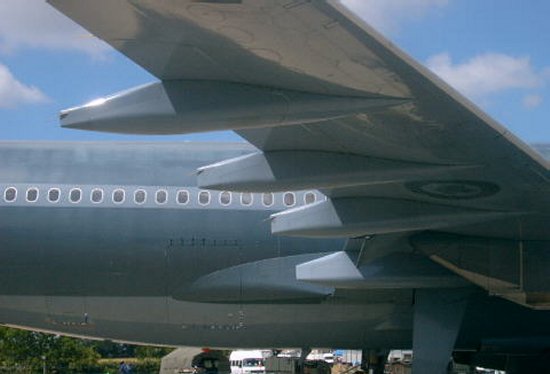 Flap track fairings under the wing of an A310 The elongated shape of these fairings that extend beyond the trailing edge of the wing are due to an aerodynamic principal called the area rule described in a previous article. The area rule was discovered in the 1950s by NASA researcher Richard Whitcomb. Whitcomb had found that maintaining a smooth distribution in the cross-sectional area of an aircraft from nose to tail significantly reduces aerodynamic drag near Mach 1. This rule of thumb was successfully used to design a number of early supersonic fighters, most notably the F-102 Delta Dagger. The influence of the area rule can also be seen in other supersonic combat aircraft like the F-105 Thunderchief, F-106 Delta Dart, B-58 Hustler, F-4 Phantom II, and B-1B Lancer 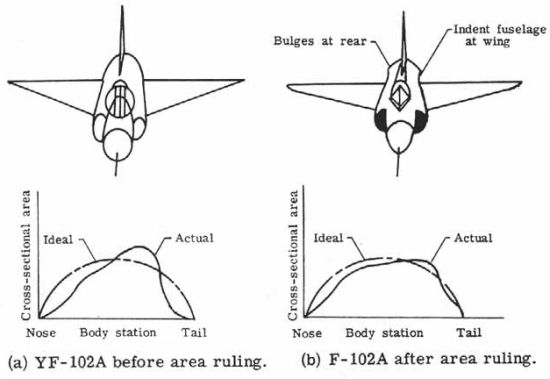 Effect of the area rule on the F-102 Even though the area rule is typically thought of only for supersonic flight, its principals are also applicable to planes traveling below the speed of sound. The area rule applies to any vehicle traveling at transonic speeds as low as approximately Mach 0.7. Most commercial airliners, including the A340, fly within the transonic region between Mach 0.8 and 0.85. The shape of the flap fairings used on these airliners helps bring the planes closer to the ideal cross-sectional area distribution of the area rule. The pods extend so far aft of the wing in order to maintain a smoother change in the area distribution along the length of the plane and reduce the overall drag. Whitcomb began exploring applications of his area rule to subsonic commercial transports during the late 1950s. He quickly discovered that making relatively minor changes to the external shape could significantly reduce the drag these aircraft experience. Compared to the radical "waisted fuselage" shaping required for supersonic flight, subsonic aircraft could be made far more efficient simply by placing elongated pods along the wing trailing edge. Whitcomb referred to these pods as "antishock bodies" like those shown in the wind tunnel model pictured below. Also note the large bulge above the forward fuselage that Whitcomb found further improves transonic aerodynamics. This concept was later adopted for the Boeing 747 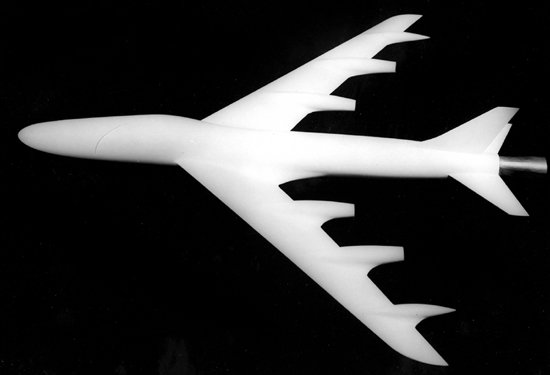 Wind tunnel research model with antishock bodies on the wing trailing edge The advantage of Whitcomb's wing pods can be appreciated by studying the following figure of a swept wing at Mach 0.9 both with and without the antishock bodies. These oil flow visualizations indicate the behavior of air as it passes over the wing. In the first image, a sharp break in the flow pattern is visible about halfway between the leading and trailing edges. This change in patterns indicates that the airflow over the aft portion of the wing has separated from its surface due to shock waves, resulting in high drag. The presence of antishock bodies, however, significantly reduces the strength of the shock waves and separated airflow is nearly eliminated. It is also interesting to note that Whitcomb later applied this same reasoning to the development of the supercritical airfoil during the 1970s  a) Large region of shock-induced flow separation on a swept wing b) virtually eliminated by antishock bodies Whitcomb's antishock body research was so promising that it suggested the economical cruising speed of a standard airliner could be increased from Mach 0.8 to as high as Mach 0.9. Convair soon put these findings into practice during the development of the CV-990 airliner. Although the competing Boeing 707 and Douglas DC-8 had already captured the bulk of the market, Convair hoped to attract customers interested in a higher cruise speed. Thanks to the addition of antishock bodies and other improvements inspired by the area rule, including modified engine nacelle and pylon shapes, Convair engineers were able to increase the economical cruise speed of the CV-990 to an impressive Mach 0.89 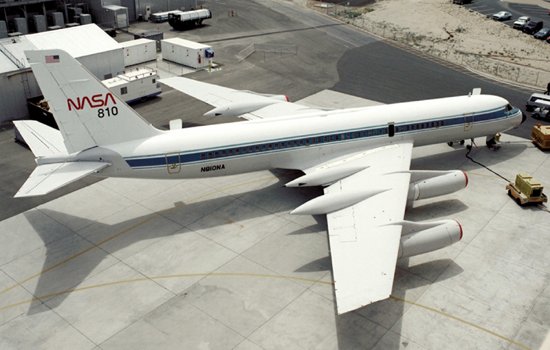 Convair 990 with Whitcomb antishock bodies on the wing trailing edge Another pioneer of the area rule concept was German aerodynamicist Dr. Dietrich Küchemann. Küchemann had been a prominent supersonic researcher in Germany during the 1930s and 1940s. He later moved to the United Kingdom and joined the Royal Aircraft Establishment (RAE) after the war. Küchemann had spent considerable time studying how air flowed around bodies at supersonic speeds and had discovered his own form of the area rule. Küchemann had approached the issue from the perspective of trying to minimize spanwise flow rather than reducing drag, but his research led to the discovery of external shaping techniques very similar to those proposed by Whitcomb. One of the concepts popularized by Küchemann was a pod located on the wing trailing edge comparable to Whitcomb's antishock body. These pods became an important factor in the design of Britain's Handley-Page Victor bomber since they significantly lowered the plane's drag and increased range. Due to their shape, these pods were often referred to as "Küchemann carrots  Handley-Page Victor showing its Küchemann carrots Yet another aircraft that benefited from the research of Whitcomb and Küchemann was the Soviet Union's revolutionary Tu-95 bomber. The Tu-95 stunned Western observers when it demonstrated the ability to cruise at jet-like speeds of Mach 0.85 or more while using propeller-driven engines. One of the reasons for this aircraft's exceptional performance was the use of large engine fairings aft of the inboard engines. These pods brought the external shape of the Tu-95 closer to an ideal area ruled configuration to reduce drag and increase maximum speed 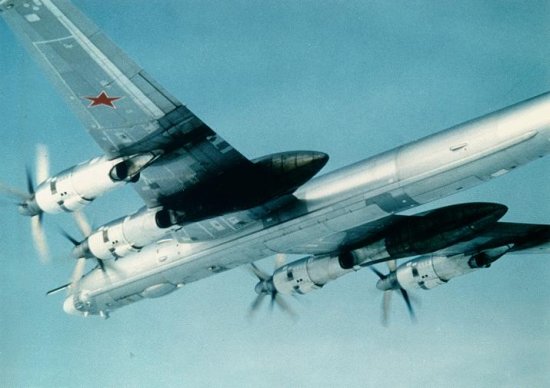 Large engine fairings of the Tupolev Tu-95 The benefits of these external pods make it clear why they are so prevalent on commercial transports today. The elongated shapes of flap track fairings obey the area rule so as to reduce the drag generated at transonic speeds. The lower the drag, the less thrust is needed to fly at the same cruise speed. Reducing the required thrust means that engines can be run at a more fuel efficient setting, and given the rising cost of oil, the plane becomes much more economical to operate. |
|||
|
|

|
| مشاركة [ 14 ] | ||||
|
||||
|
|
والله سالت مساعد طيار في الخطوط السعوديه وقالي انها مانعت الصواعق هل هذا صحيح
|
|||
|
|

|
| مشاركة [ 15 ] | ||||
|
||||
|
|
نعم صحيح هذي مانع صواعق
|
|||
|
|

|
| مشاركة [ 16 ] | |||
|
|||
|
مساعد طيار
 |
أخوي , الأخوان جزاهم الله خير شرحوا الأجزاء اللي في الجناح الأمامي .
أما أنا راح أشرح لك الأجزاء في الجناح الخلفي stabilizer في الجزء الأفقي :- الروافع elevators :- وظيفتها : عمل رفع للطائرة , بحيث أنه يعمل على تغيير زاوية الهجوم للطائرة . و يوجد أيضاا ( مدقق الروافع ) و يعمل على وزن الزاوية بدقة أكبر . في الجزء العمودي vertical stabilizer :- الدفة ( rudder ) وهي تعمل على تحريك الطائرة يمينا و يسارا مع عدم ميلانها ( مثل حركة السيارة على الطريق ) . و الحركة تكون حول المحور العمودي للطائرة . مدقق الدفة : و يعمل على التدقيق أيضا . و إن شاء الله تكون إستفدت ( قولوا ما شاء الله ) |
||
|
|

|
| مشاركة [ 17 ] | ||||
|
||||
|
|
حياك الله كابتن عبدالسلام لم تحدد اين بالضبط في الصورة لكن اذا كنت تقصد هذي القطعة  فهذه تسمى بالFairing وهي مصنعة من مواد مركبة composite خفيفة الوزن تقوم على حماية الأجزاء الداخلية لل flap transmission وهي وحدة تحريك الflap ,ويكون ذلك بتدوير ال ball screw وعند دورانه يتحرك ال carriage وهي قطعة من المعدن تقوم على حمل الflap فعندما يقوم الطيار بإنزال الflap يدور ال ball screw عكس عقارب الساعة مما يجعل ال carriage يتحرك بعيداً عن الجناح كما هو موضح في الصورة  والفائدة الثانية للFairing المحافظة على الشكل الديناميكي لتقليل الDrag الحاصل نتيجة إصطدام الهواء بالطائرة أتمنى أن أكون وضحت المطلوب وحياك الله
حيياك الله اخي ابو ود اجابة رائعة ومعلومات جميلة |
|||
|
|

|
| مشاركة [ 18 ] | ||||
|
||||
|
|
I believe the A340 pods you are referring to are the flap track fairings located along the trailing edge of the wing. These fairings house the mechanisms used to deploy the wing flaps. The pods are not unique to the A-340 but are carried aboard virtually every airliner in use today, including all Boeing and Airbus models in production. Examples of flap track fairings can be seen in the following picture of an A-310 useful informations thanks  Flap track fairings under the wing of an A310 The elongated shape of these fairings that extend beyond the trailing edge of the wing are due to an aerodynamic principal called the area rule described in a previous article. The area rule was discovered in the 1950s by NASA researcher Richard Whitcomb. Whitcomb had found that maintaining a smooth distribution in the cross-sectional area of an aircraft from nose to tail significantly reduces aerodynamic drag near Mach 1. This rule of thumb was successfully used to design a number of early supersonic fighters, most notably the F-102 Delta Dagger. The influence of the area rule can also be seen in other supersonic combat aircraft like the F-105 Thunderchief, F-106 Delta Dart, B-58 Hustler, F-4 Phantom II, and B-1B Lancer  Effect of the area rule on the F-102 Even though the area rule is typically thought of only for supersonic flight, its principals are also applicable to planes traveling below the speed of sound. The area rule applies to any vehicle traveling at transonic speeds as low as approximately Mach 0.7. Most commercial airliners, including the A340, fly within the transonic region between Mach 0.8 and 0.85. The shape of the flap fairings used on these airliners helps bring the planes closer to the ideal cross-sectional area distribution of the area rule. The pods extend so far aft of the wing in order to maintain a smoother change in the area distribution along the length of the plane and reduce the overall drag. Whitcomb began exploring applications of his area rule to subsonic commercial transports during the late 1950s. He quickly discovered that making relatively minor changes to the external shape could significantly reduce the drag these aircraft experience. Compared to the radical "waisted fuselage" shaping required for supersonic flight, subsonic aircraft could be made far more efficient simply by placing elongated pods along the wing trailing edge. Whitcomb referred to these pods as "antishock bodies" like those shown in the wind tunnel model pictured below. Also note the large bulge above the forward fuselage that Whitcomb found further improves transonic aerodynamics. This concept was later adopted for the Boeing 747  Wind tunnel research model with antishock bodies on the wing trailing edge The advantage of Whitcomb's wing pods can be appreciated by studying the following figure of a swept wing at Mach 0.9 both with and without the antishock bodies. These oil flow visualizations indicate the behavior of air as it passes over the wing. In the first image, a sharp break in the flow pattern is visible about halfway between the leading and trailing edges. This change in patterns indicates that the airflow over the aft portion of the wing has separated from its surface due to shock waves, resulting in high drag. The presence of antishock bodies, however, significantly reduces the strength of the shock waves and separated airflow is nearly eliminated. It is also interesting to note that Whitcomb later applied this same reasoning to the development of the supercritical airfoil during the 1970s  a) Large region of shock-induced flow separation on a swept wing b) virtually eliminated by antishock bodies Whitcomb's antishock body research was so promising that it suggested the economical cruising speed of a standard airliner could be increased from Mach 0.8 to as high as Mach 0.9. Convair soon put these findings into practice during the development of the CV-990 airliner. Although the competing Boeing 707 and Douglas DC-8 had already captured the bulk of the market, Convair hoped to attract customers interested in a higher cruise speed. Thanks to the addition of antishock bodies and other improvements inspired by the area rule, including modified engine nacelle and pylon shapes, Convair engineers were able to increase the economical cruise speed of the CV-990 to an impressive Mach 0.89  Convair 990 with Whitcomb antishock bodies on the wing trailing edge Another pioneer of the area rule concept was German aerodynamicist Dr. Dietrich Küchemann. Küchemann had been a prominent supersonic researcher in Germany during the 1930s and 1940s. He later moved to the United Kingdom and joined the Royal Aircraft Establishment (RAE) after the war. Küchemann had spent considerable time studying how air flowed around bodies at supersonic speeds and had discovered his own form of the area rule. Küchemann had approached the issue from the perspective of trying to minimize spanwise flow rather than reducing drag, but his research led to the discovery of external shaping techniques very similar to those proposed by Whitcomb. One of the concepts popularized by Küchemann was a pod located on the wing trailing edge comparable to Whitcomb's antishock body. These pods became an important factor in the design of Britain's Handley-Page Victor bomber since they significantly lowered the plane's drag and increased range. Due to their shape, these pods were often referred to as "Küchemann carrots  Handley-Page Victor showing its Küchemann carrots Yet another aircraft that benefited from the research of Whitcomb and Küchemann was the Soviet Union's revolutionary Tu-95 bomber. The Tu-95 stunned Western observers when it demonstrated the ability to cruise at jet-like speeds of Mach 0.85 or more while using propeller-driven engines. One of the reasons for this aircraft's exceptional performance was the use of large engine fairings aft of the inboard engines. These pods brought the external shape of the Tu-95 closer to an ideal area ruled configuration to reduce drag and increase maximum speed  Large engine fairings of the Tupolev Tu-95 The benefits of these external pods make it clear why they are so prevalent on commercial transports today. The elongated shapes of flap track fairings obey the area rule so as to reduce the drag generated at transonic speeds. The lower the drag, the less thrust is needed to fly at the same cruise speed. Reducing the required thrust means that engines can be run at a more fuel efficient setting, and given the rising cost of oil, the plane becomes much more economical to operate.
useful informations thanks |
|||
|
|

|
| مشاركة [ 19 ] | |||
|
|||
|
مساعد طيار
 |
جزاكم الله خير و مشكورين على المعلومات القيّمة ...
|
||
|
|

|
| مشاركة [ 20 ] | ||||
|
||||
|
|
والله سالت مساعد طيار في الخطوط السعوديه وقالي انها مانعت الصواعق هل هذا صحيح
شكلك ما نقلت له الصوره بدقه . ارجو ان ترجع لرد العضو mechanic لكونه مبسطا ووافيا . واذا كان نقلك صحيحا للكابتن وهذه اجابته ارجو ابلاغه بان يراجع معلوماته لانها خطا 100% وشخصيا اشك ان يكون هناك طيارا لايعرف ال flap tracks fairings> وللمعلوميه يمكن لبعض الطائرات الطيران وواحد من هذه ال fairings مفقودا حسب كتب الطائره المعتمده من الشركه المصنعه وسلطات الطيران (CDL) ولكن هناك ضريبه على ذلك من وقود وسرعه وارتفاع وهو ليس محببا ولكن يمكن اللجؤ اليه لتفادي اخراج الطائره عن الخدمه |
|||
|
|

|
| مشاركة [ 21 ] | ||||
|
||||
|
|
نفس ما وضح لك اخوي ميكانك .. لحفظ انظمة الهيدروليك لتحريك الفلابس
|
|||
|
|

|
| مشاركة [ 22 ] | ||||
|
||||
|
|
شكرا لكم جميعاً.
لكن لها أيضاً وظيفة مهمة جداً كما اشار الصديق المشارك بالموضوع باللغة الانكليزية، وهي منع انتشار ونمو الطبقة الحدية على امتداد باع "عرض" الجناح. حيث يُحتجز الجريان ضمن اثنتان من "Fairing" مما يساعد في حصر الجريان ضمن مسريين وضمان عدم تداخل الطبقات الحدية وانجراف الجريان عبر باع "عرض" الجناح مما يعطي فعالية آيروديناميكية أكبر للجناح وتقليل الجر بنسبة 20% الأمر الذي يزيد من فعالية الجناح. |
|||
|
|

|
| مشاركة [ 23 ] | |||
|
|||
|
عضو خط الطيران
|
السلام عليكم
انها شروحات متكاملة ,أشكركم على كل هده المعلومات |
||
|
|

|
| إضافة رد |
 هندسة وصيانة الطائرات Engineering & Aircraft Maintenance
هندسة وصيانة الطائرات Engineering & Aircraft Maintenance
|
|
|
|
|
|
 المواضيع المتشابهه
المواضيع المتشابهه
|
||||
| الموضوع | المنتدى | |||
| السياحة في سلطنة عمان | الخليج العربي - Arabian Gulf | |||
| طائرات الحرب الالكترونية ... | سـاحـة الطائرات Aircraft yard | |||
| ميثاق مونتريال ضد التخريب | السلامة الجوية Flight Safety | |||
| المواد الممنوع والمقيد استيرادها إلى السعودية | القسم العام | |||